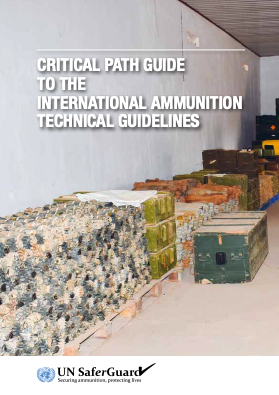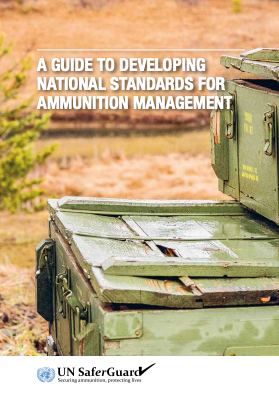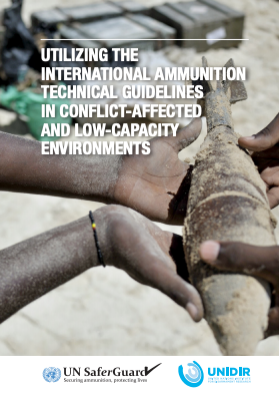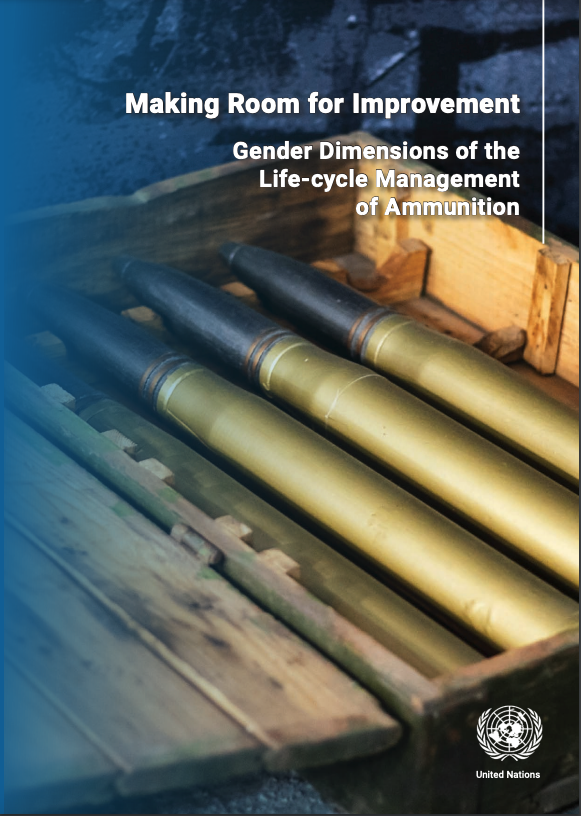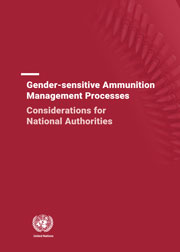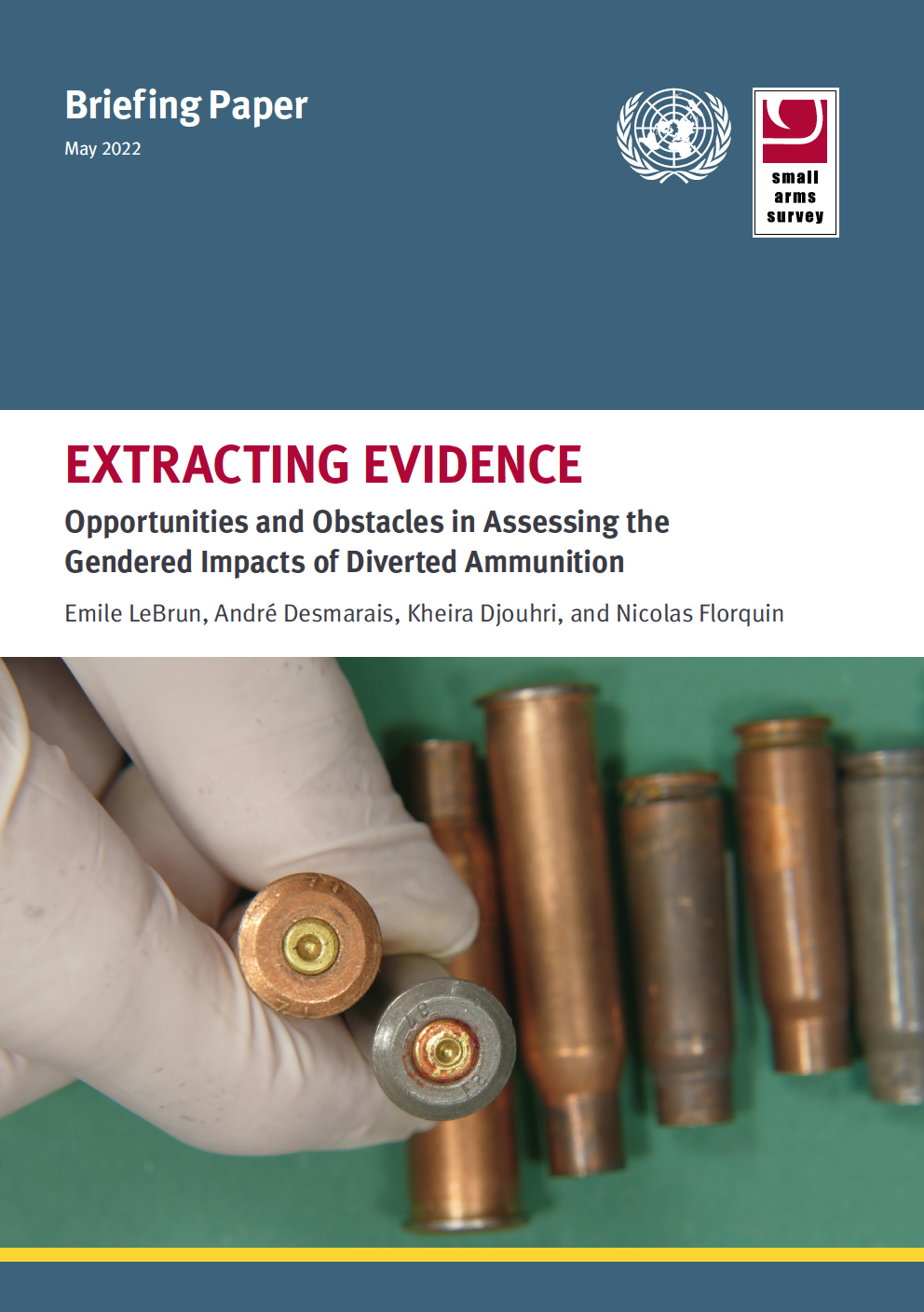Safe and secure management of ammunition through the UN SaferGuard Programme
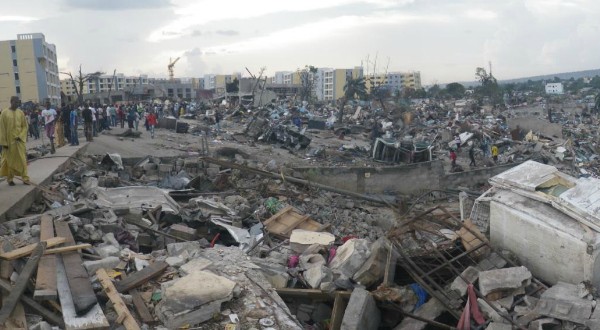
Photo: Erwan Morand.
In more than 100 countries, over the past five decades, poorly-managed ammunition stockpiles have resulted in explosions, often bringing about humanitarian disasters. Thousands of people have been killed, injured and displaced, and the livelihoods of entire communities have been disrupted.
In addition to the humanitarian and socio-economic consequences, unsecured or poorly managed ammunition stockpiles fuel insecurity. Massive diversion of ammunition to illicit markets has been a catalyst for armed conflict, organized crime and terrorism. Moreover, diverted ammunition is increasingly used to assemble improvised explosive devices.
Taken together, these consequences demonstrate the very serious safety and security challenges posed by inadequately-managed stockpiles.
In response to these concerns, the General Assembly requested the United Nations to develop guidelines for adequate ammunition management to ensure that the United Nations consistently delivers high-quality advice and support (A/RES/63/61).
As a result, the International Ammunition Technical Guidelines (IATG) were developed in 2011 and the UN SaferGuard Programme was established as the corresponding knowledge management platform.
The UN SaferGuard Programme, managed by the UN Office for Disarmament Affairs oversees the maintenance, updating and dissemination of the IATG.
Casualties of unplanned explosions at munitions sites (UEMS) 1979-2021
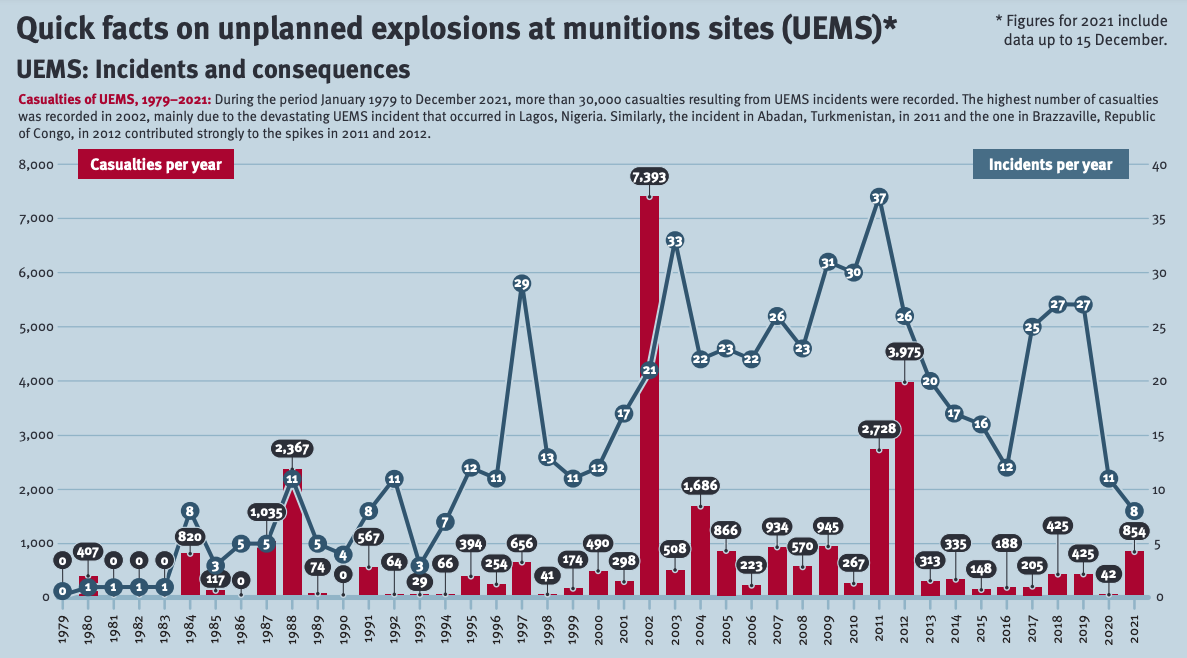
IATG Implementation Support Toolkit
The web-based applications in this toolkit support the implementation of the International Ammunition Technical Guidelines (IATG). The scientific background of the underlying formulae is summarized and referenced in IATG 1.80.
Ammunition experts are invited to use the resources on this website to implement best-practices that will improve the safety, security and efficiency in conventional ammunition stockpile management. These tools may also be used to communicate safety and security requirements to policy-makers and other stakeholders.
Risk Management
Technical Calculators
Calculators for Demolition
International Ammunition Technical Guidelines
IATG Version 3 is currently available in Arabic, French and English. The Office for Disarmament Affairs will continue to strive to make the IATG available in additional languages.
Please consult the AMAT Insights for a practical and detailed overview of the amendments made in IATG Version 3, the rationale behind them, and their expected impact.
Compiled Arabic version of the IATG
Compiled English version of the IATG
Compiled French version of the IATG
- 01 - Introduction and Principles of Ammunition Management
-
01.10 - Guide to the International Ammunition Technical Guidelines (IATG)
Version 3: Arabic English FrenchVersion 2: Portuguese Russian Spanish
01.20 - Index of risk reduction process levels (RRPL) within IATG
Version 3: Arabic English French
Version 2: Portuguese Russian Spanish
01.30 - Policy development and advice
Version 3: Arabic English French
Version 2: Portuguese Russian Spanish
01.35 - Organisational Capabilities
Version 3: Arabic English French
01.40 - Glossary of terms, definitions and abbreviations
Version 3: Arabic English French
Version 2: Portuguese Russian Spanish
01.50 - UN explosive hazard classification system and codes
Version 3: Arabic English French
Version 2: Portuguese Russian Spanish
01.60 - Ammunition faults and performance failures
Version 3: Arabic English French
Version 2: Portuguese Russian Spanish
01.70 - Bans and constraints
Version 3: Arabic English French
Version 2: Portuguese Russian Spanish
01.80 - Formulae for ammunition management
Version 3: Arabic English French
Version 2: Portuguese Russian Spanish
01.90 - Ammunition management personnel competences (new module)
Version 3: Arabic English French
Version 2: Portuguese Russian Spanish
- 02 - Risk Management
-
02.10 - Introduction to risk management principles and processes
Version 3: Arabic English FrenchVersion 2: Portuguese Russian Spanish
02.20 - Quantity and separation distances
Version 3: Arabic English French
Version 2: Portuguese Russian Spanish
02.30 - Licensing of explosive facilities
Version 3: Arabic English French
Version 2: Portuguese Russian Spanish
02.40 - Safeguarding of explosive facilities
Version 3: Arabic English French
Version 2: Portuguese Russian Spanish
02.50 - Fire safety
Version 3: Arabic English French
Version 2: Portuguese Russian Spanish
- 03 - Ammunition Accounting
-
03.10 - Inventory management
Version 3: Arabic English French
Version 2: Portuguese Russian Spanish
03.20 - Lotting and batching
Version 3: Arabic English French
Version 2: Portuguese Russian Spanish
- 04 - Explosive Facilities (Storage) (Field and Temporary Conditions)
-
04.10 - Temporary storage
Version 3: Arabic English French
Version 2: Portuguese Russian Spanish
- 05 - Explosives Facilities (Storage) (Infrastructure and Equipment)
-
05.10 - Planning and siting of explosives facilities
Version 3: Arabic English French
Version 2: Portuguese Russian Spanish
05.20 - Types of buildings for explosives facilities
Version 3: Arabic English French
Version 2: Portuguese Russian Spanish
05.30 - Traverses and barricades
Version 3: Arabic English French
Version 2: Portuguese Russian Spanish
05.40 - Safety standards for electrical installations
Version 3: Arabic English French
Version 2: Portuguese Russian Spanish
05.50 - Vehicles and mechanical handling equipment (MHE) in explosives facilities
Version 3: Arabic English French
Version 2: Portuguese Russian Spanish
05.60 - Radio frequency hazards
Version 3: Arabic English French
Version 2: Portuguese Russian Spanish
- 06 - Explosive Facilities (Storage) (Operations)
-
06.10 - Control of explosives facilities
Version 3: Arabic English FrenchVersion 2: Portuguese Russian Spanish
06.20 - Storage space requirements
Version 3: Arabic English French
Version 2: Portuguese Russian Spanish
06.30 - Storage and handling
Version 3: Arabic English French
Version 2: Portuguese Russian Spanish
06.40 - Ammunition packaging and marking
Version 3: Arabic English French
Version 2: Portuguese Russian Spanish
06.50 - Specific safety precautions (storage and operations)
Version 3: Arabic English French
Version 2: Portuguese Russian Spanish
06.60 - Works services (construction and repair)
Version 3: Arabic English French
Version 2: Portuguese Russian Spanish
06.70 - Inspection of explosives facilities
Version 3: Arabic English French
Version 2: Portuguese Russian Spanish
- 07 - Ammunition Processing
-
07.10 - Safety and risk reduction (ammunition processing operations)
Version 3: Arabic English French
Version 2: Portuguese Russian Spanish
07.20 - Inspection of ammunition
Version 3: Arabic English French
Version 2: Portuguese Russian Spanish
07.30 - Ammunition processing operations - Safety, risk reduction and mitigation
- 08 - Transport of Ammunition
-
08.10 - Transport of ammunition
Version 3: Arabic English French
Version 2: Portuguese Russian Spanish
08.20 - Storage and handling of ammunition and explosives at airfields
- 09 - Security of Ammunition
-
09.10 - Security principles and systems
Version 3: Arabic English French
Version 2: Portuguese Russian Spanish
- 10 - Ammunition Demilitarization and Destruction
-
10.10 - Demilitarization and destruction and logistic disposal of conventional ammunition
Version 3: Arabic English French
Version 2: Portuguese Russian Spanish
- 11 - Ammunition Accidents, Reporting and Investigation
-
11.10 - Ammunition accidents: reporting and investigation
Version 3: Arabic English French
Version 2: Portuguese Russian Spanish
11.20 - Clearance storage area explosions – EOD clearance
Version 3: Arabic English French
Version 2: Portuguese Russian Spanish
- 12 - Ammunition Operational Support
-
12.10 - Ammunition on multi-national operations
Version 3: Arabic English French
Version 2: Portuguese Russian Spanish
12.20 - Small unit ammunition storage
Version 3: Arabic English French
Version 2: Portuguese Russian Spanish












